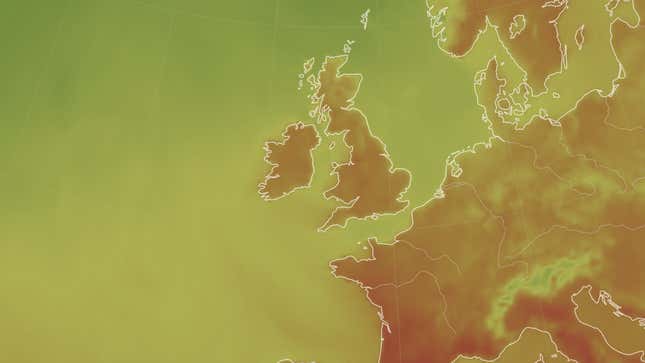
In 2021, nowhere on Earth is safe from searing temperatures—not the Pacific Northwest, nor Siberia, nor, it seems, the UK. The country’s Met Office issued its first-ever extreme heat alert Monday to warn residents of temperatures coming this week that could exceed 91.4 degrees Fahrenheit (33 degrees Celsius) in some areas.
The agency said on Monday that it was issuing an amber warning for the upcoming week as it anticipated continued high temperatures through Thursday. The warning comes on the heels of a particularly scorching week for the UK. Northern Ireland recorded its highest-ever temperature—88.2 degrees Fahrenheit (31.2 degrees Celsius)—on Saturday, while Scotland, Wales, and England all recorded record highs for the year over the weekend as well. On Sunday night, temperatures at London’s Heathrow Airport hovered around 82.4 degrees Fahrenheit (29 degrees Celsius) at 9 p.m. local time. On Monday, temperatures reached 86 degrees Fahrenheit (30 degrees Celsius) in the city itself. The Met Office’s warning, which covers Wales and much of southern and western England, comes paired with a corresponding health alert warning the public to look out for older and younger people and stay hydrated.
Some of these temperatures might sound like small potatoes to Americans or folks in other parts of the world living through routinely blistering summers, but they’re pretty high for our English friends. The average temperature for July in the UK—defined as the period from 1981 to 2010—is 59.2 degrees Fahrenheit (15.1 degrees Celsius), a far cry from the temperatures the continent is seeing this week. In 2008, just half a percent of UK homes had air conditioning installed; thanks to routinely increasing temperatures, there has been an uptick of interest and installation over the past decade.
The warning is part of a new system launched by the Met Office just last month to keep residents safe from extreme heat. It’s unfortunate it got the chance to test it so soon. The warning issued this week—amber—is one step below the more extreme red level the Met Office set for its highest warnings. The office said that the new warnings would be based on the context of the impacts extreme weather might have on a specific area, rather than simply issuing an alert when a place passes a certain temperature.
“Although hot weather can often be seen as ‘good news’ and is enjoyed by many, it can have serious consequences,” the Met Office said in a blog post announcing the new system last month. “Research shows that, as a result of climate change, we are now much more likely to see prolonged spells of hot weather here in the UK.”
The same is true in other parts of the world, which have been roasted by heat waves this year. The Pacific Northwest lived through a 1-in-1,500 year heat wave earlier this month. The heat was juiced by climate change and had deleterious impacts on public health and ecosystems. More heat has blasted the West in recent weeks as well while heat records fell across parts of western Europe and Russia last month. The continent is also reeling from floods that have caused enormous damage across multiple countries. It shows no place is safe from the crisis, and adapting to increasingly extreme weather has never been more urgent.